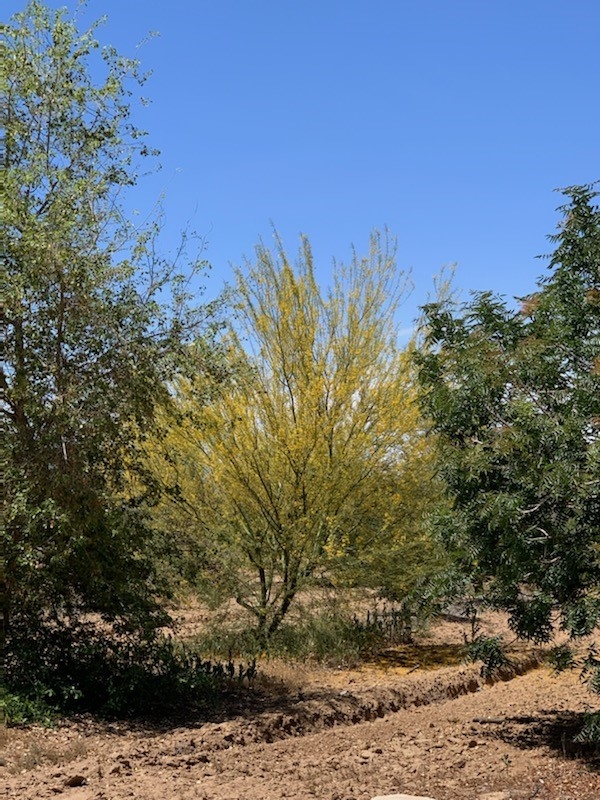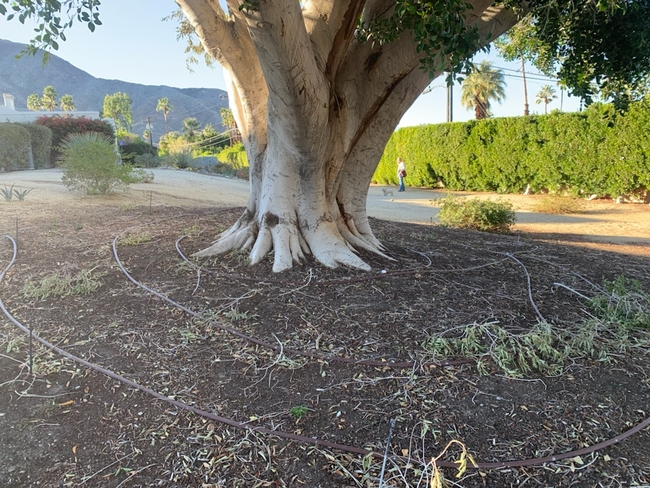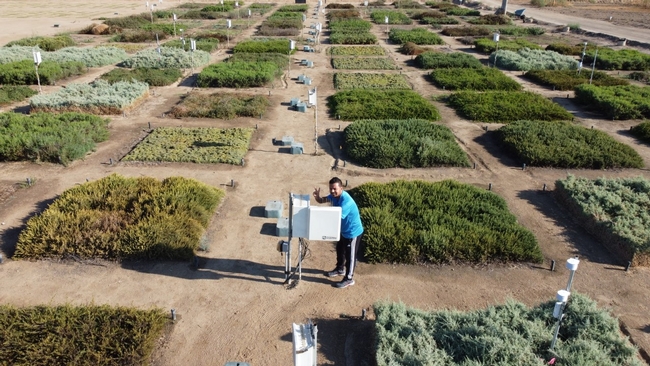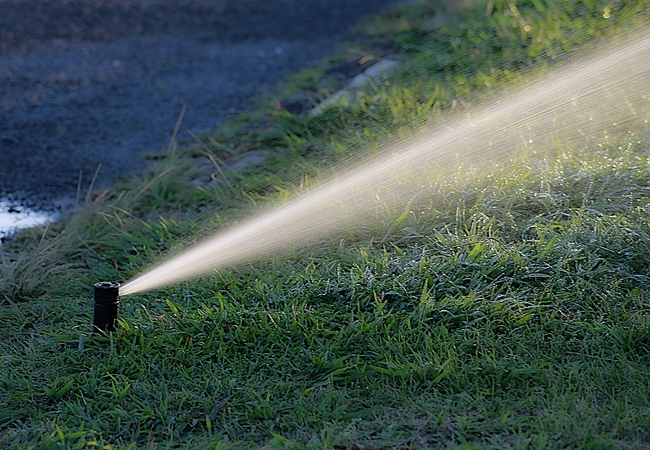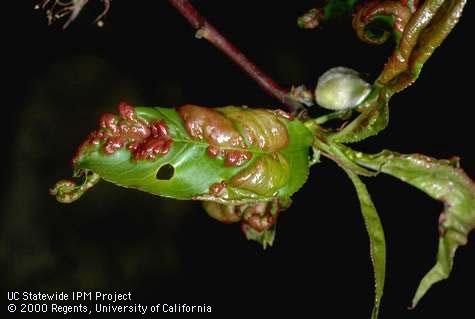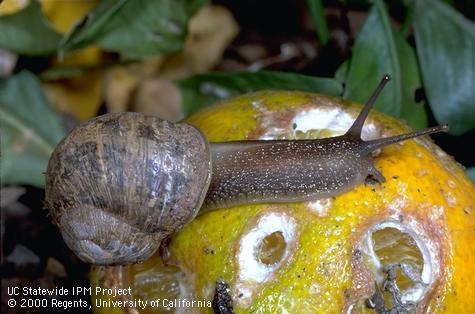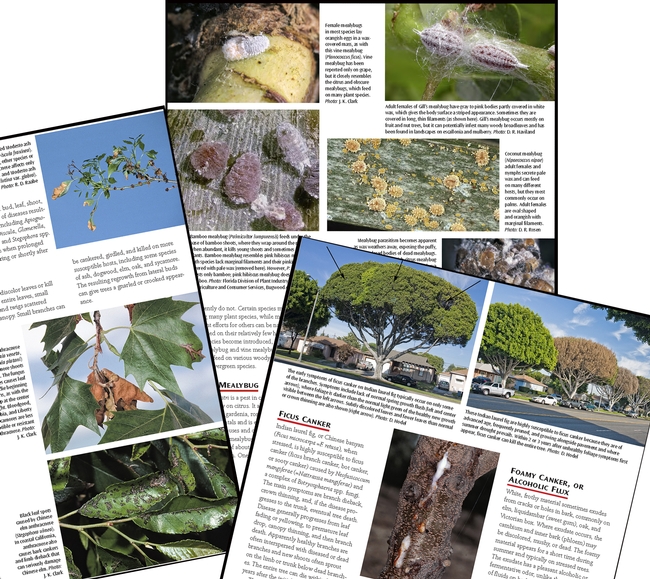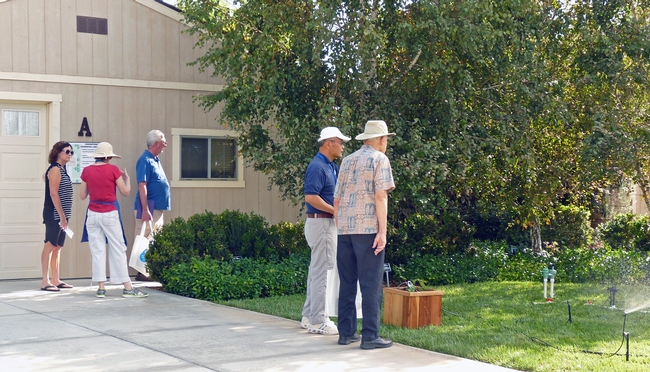Posts Tagged: Landscape
Save trees first: Tips to keep them alive during drought
Trees essential to lowering temperatures, cooling ‘heat islands'
Water restrictions prompted by the drought are driving Californians to prioritize how they will use their limited water. Because landscape irrigation is a major water use for many households, residents are looking outdoors to conserve water.
When choosing which landscape plants to save, “trees come first,” said Janet Hartin, UC Cooperative Extension area environmental horticulture advisor for San Bernardino, Los Angeles and Riverside counties. “Healthy communities need trees. Fortunately new California water restrictions allow for provisions to ensure trees receive adequate water to stay alive and healthy.”
“Mature trees are instrumental in cooling urban heat islands and we can't afford to lose them and start all over,” Hartin said. “Shade from mature trees can reduce surface temperatures by as much as 65 degrees in asphalt-covered parking lots. Shade from a single tree can reduce these surface temperatures from 165 to less than 100 degrees when air temperatures reach 110 degrees. Even with air temperatures in the 90s, surface temperatures can reach 140 degrees.”
In addition to providing shade, trees absorb and store carbon dioxide, release oxygen, enhance pollinators and wildlife habitat, filter pollutants from air and water and can reduce energy use, according to Hartin. Because trees take years to grow, they aren't as easily replaced as other plants.
As residents let lawns go brown, she recommends watering trees that are near or surrounded by lawn.
“If a tree is in the middle of a lawn, it is almost certainly watered by lawn irrigation,” Hartin said. “If it's not on a separate drip system, drag out a hose and allow the water to slowly trickle into the soil early in the morning or in the evening. Deep watering for two hours once every couple of weeks will keep most established trees alive."
In most jurisdictions, watering restrictions do not apply to hand watering and hand-held watering devices such as hoses, which may be used for longer periods of time than the restrictions permit otherwise. However, watering may be restricted in all cases to prescribed times of day.
“Check to see if your jurisdiction also requires a hose shutoff valve,” Hartin said.
“For fruit trees, we may have to forgo fruit production for a year or so. There may not be enough water to support fruit production, but the goal is to keep the trees alive during the drought,” she said.
She recommends watering trees away from the trunk, halfway between the trunk and the dripline – where the foliage ends and rain drips off the leaves – because “roots grow outward quite a distance as well as downward. Leave the hose on so the water is just trickling out,” she said. “You want water to seep into the soil and encourage the roots to grow deeper. The slow water flow will seep down a foot or so and the roots will follow, which will help anchor the tree. Move the hose around every half hour to hour in quadrants around the tree for more even watering.”
Don't have time to move the hose? Hartin suggests getting a soaker hose and wrapping it in concentric circles 2 to 3 feet apart.
“Soaker hoses are made from recycled tire rubber and allow water to slowly ooze out of the pores along the hose, distributing the water fairly evenly throughout the hose length. Avoid using soaker hoses longer than 75 feet due to pressure issues.”
To reduce evaporation around the tree, spreading mulch a few inches from trunk can help.
“Dark mulches can heat the environment so it's best not to use them,”Hartin said. “If you are in a fire-prone area, don't use organic wood-based mulches because they are flammable. Use decomposed gravel or pebbles, rock-based products instead. To keep sunlight out and discourage weeds, large wood chip mulches should be maintained 3-4-inches deep and smaller inorganic mulches at 1-2 inches.”
Residents may want to maintain some grass for children and pets because bare feet and paws can sustain serious burns on surfaces hotter than 120 degrees.
“People don't realize how hot fake grass can get,” Hartin said. “Research I conducted last summer in the Coachella Valley and Redlands found that surface temperatures of synthetic lawns can be more than 65 degrees higher than living turf and groundcover surfaces on several dates in between May and August.”
For California lawns, there are drought-tolerant grasses that can thrive on 30% less water than bluegrass and other cool season varieties. Examples are buffalograss and bermudagrass. They still require maintenance, such as mowing, but are great for play and recreational surfaces for people and pets.
Jim Baird, UC Cooperative Extension turf specialist based at UC Riverside, said, “Turfgrasses offer numerous recreational, aesthetic, and environmental benefits including player safety, property value, mental health, erosion control, groundwater recharge and surface water quality, organic chemical decomposition, carbon sequestration and environmental cooling.”
There are also non-turf groundcovers that are drought resistant.
“As they transpire, plants cool the environment. We have more and more drought-resistant alternatives to high-water-requiring plants on the market now, and that's where we should be going,” Hartin said.
For people considering replacing their lawns and adding new landscape plants, she recommends planting low-water using groundcovers in the fall.
“It's too hot to plant in summer and even native and drought-resistant plants require water several times week until they get established,” she said.
Most counties have a UC Master Gardener Program with a helpline staffed by well-trained volunteers dispensing advice to help keep plants alive and recommend plants that are well-suited for the local environment. Find a local UC Master Gardener Program at https://mg.ucanr.edu/FindUs.
University of California Cooperative Extension
Drought and Landscape Tree Care Resources
Keeping Plants Alive Under Drought and Water Restrictions (English)
https://anrcatalog.ucanr.edu/pdf/8553.pdf
Mantener las plantas del exterior vivas con poca agua (Spanish)
https://anrcatalog.ucanr.edu/pdf/8628.pdf
Prioritizing Trees Under Drought and Water Restrictions (5-minute video)
https://www.youtube.com/watch?v=CTKLlJgdLVk
Tips to Keep Your Landscape Trees Alive During Drought
Landscape Tree Irrigation to Maximize Tree Health, Benefits, and Beauty
Landscape Tree Irrigation 101
Top 10 Ways to Conserve Water in Your Landscape and Garden
Use of Graywater in Urban Landscapes in California
https://anrcatalog.ucanr.edu/Details.aspx?itemNo=8536
UC Master Gardeners ‘Garden Walks’ conserves millions of gallons of water annually in Marin
The Marin Municipal Water District has saved nearly 30 million gallons of water since it initiated a partnership with UC Cooperative Extension's Master Gardener program in Marin to teach residents how to conserve water.
The program, Garden Walks, was established in 2008 to help Marin conserve water in a district with limited supply. MMWD purchases about 75% of its water from reservoirs on Mt. Tamalpais and in west Marin, and the rest from Sonoma County's Russian River water system.
Garden Walks provides personalized information and advice to water district customers focused on improving their irrigation practices to conserve water. The part-time coordinator sets up about 150 appointments a year for UC Master Gardener volunteers to visit the homes of Marin County residents and teach them how to manage their outdoor water usage with conservation in mind.
“When we finish our visits, I hope that the client is more confident about being proactive in their garden,” said Pam Polite Fisco, the program coordinator. “We hope they will be saving water, will use natives and will encourage wildlife in their gardens.”
The volunteers, dispatched in pairs, spend about an hour at the homes. They walk the garden and talk with residents about grouping plants with similar water requirements, adding mulch to the soil surface and composting clippings, leaves and other green waste so it stays on the property.
The UC Master Gardeners teach the residents how to check their water meters and use the meter to help determine whether there are leaks in the system. They provide advice on water-conserving plants, such as natives or other drought-tolerant plants. They ask the residents to run their sprinklers and other irrigation systems to ensure they know how to manage the controls.
The majority of the water savings realized by the program stems from repairing leaks and cutting back on overwatering, said Steven Swain, UC Cooperative Extension horticulture advisor and the technical advisor to the Marin County Master Gardener program.
As part of their agreement with UC Cooperative Extension, the Marin Water District monitors changes in water usage and reports them annually on their website, allowing Swain to determine the program's impact.
The majority of water savings during the life of the program is attributable to just one quarter of the houses Master Gardeners visited; three quarters of participants were managing water sustainably.
“Sometimes, our volunteers just give the residents a pat on the back and compliment them for a job well done,” Swain said.
About 6% of the clients visited have hidden water leaks in their irrigation systems. These leaks can waste huge amounts of water if not caught, and account for a large portion of the water savings. Another 18% of clients are overwatering, which accounts for much of the rest of the savings.
Considering the value of the water conserved by the Garden Walks program, the $40,000 annual cost to hire the coordinator is more than offset by the reducing amount of water the district must provide.
This program has received a number of awards, including the Marin Conservation League's Ted Wellman Water Award in 2010. In 2011, it received first place in the UC Master Gardener's Search For Excellence awards and the Community Outreach Award at the National Extension Master Gardener Coordinating Conference. Marin County residents have also praised the program.
“The Master Gardener team was friendly, professional and helpful and shared their positive attitude to their garden and their outreach,” said Fairfax resident ‘Julie' in a follow-up survey
‘Jean' of San Rafael said, “I'm a beginning gardener. They helped me figure out how to start off right.”
A number of California counties were inspired by the success of the Marin County Garden Walks program and have adopted similar efforts to visit homeowners and assess irrigation efficiency.
View a video about the Marin Garden Walks porgram:
Top 10 pests in gardens and landscapes and how to control them
Download the free booklet at the bottom of the page!
1. Ants
Most people deal with ants around their home at some point. Because most ants live outdoors, focus efforts on keeping ants from entering buildings by caulking entryways. Follow good sanitation practices to make your home less attractive to ants. Spraying ants inside the home will not prevent more ants from entering. Use baits to control the ant colony. Pesticide baits work by attracting worker ants who then take the poison back to the nest where the entire colony, including queens, can be killed. In the landscape, ants protect honeydew-producing pest insects from predators, so use sticky barriers or insecticide baits to keep ants out of trees and shrubs.
- Find out more at http://www.ipm.ucanr.edu/QT/antscard.html
2. Aphids
Aphids can curl leaves and produce sticky honeydew, but they rarely kill plants and you usually can wash them off with water. When aphid numbers get high, natural enemies such as lady beetles (lady bugs), lacewings, syrphid fly larvae, soldier beetles and others frequently feed on them, eliminating the need for pesticides. Protect these good bugs by avoiding the use of insecticides that can be toxic to a broad variety of insects. Ants protect aphids from these natural enemies, so keep ants away from your garden as well. When pesticides are necessary, use less toxic products such as insecticidal soaps and oils.
- Learn more about controlling aphids here: http://www.ipm.ucanr.edu/QT/aphidscard.html
3. Asian citrus psyllid and Huanglongbing disease
The Asian citrus psyllid (ACP) and the deadly bacterial disease it spreads, Huanglongbing (HLB), threaten citrus trees in backyards and on farms. There is no cure or effective control method for HLB disease. All types of citrus—including oranges, grapefruit, lemons, and mandarins—are affected as well as a few closely related ornamentals. ACP and HLB have already devastated the Florida citrus industry, and now that it is in the Western U.S. it is threatening the California citrus industry as well.
- See where the outbreaks are in California with our helpful Asian citrus psyllid website: http://ucanr.edu/sites/ACP/Distribution_of_ACP_in_California/
- Contact your agricultural commissioner's office, or call the California Department of Food and Agriculture (CDFA) Exotic Pest Hotline at 1-800-491-1899 to confirm a find. Learn more about ACP here: http://www.ipm.ucanr.edu/QT/asiancitruscard.html
4. Gophers
Gophers are small burrowing rodents that feed on roots of many types of plants. A single gopher can ruin a garden in a short time, and gopher gnawing can damage irrigation lines and sprinkler systems. In lawns, their mounds are unsightly and interfere with mowing. Early detection is critical to prevent damage. Use both traps and underground fencing to manage gopher problems. Toxic baits are available but can pose threats to wildlife, pets, and children, especially in backyard situations.
- Learn more about protecting your garden and landscape from gophers here: http://www.ipm.ucanr.edu/QT/gopherscard.html
5. Leaf-feeding caterpillars
Caterpillars, which are the larvae of butterflies and moths, damage plants by chewing on leaves, flowers, shoots, and fruit. Caterpillars in fruit or wood can be difficult to manage because they are hidden most of their life and can cause serious damage even when numbers are low. However, many plants, especially perennials, can tolerate substantial leaf damage, so a few leaf-feeding caterpillars often aren't a concern. Handpicking and beneficial predators and parasites often provide sufficient control. Look for feeding holes, excrement, webbed or rolled leaves, caterpillars, eggs, and good bugs.
- Learn more here:http://www.ipm.ucanr.edu/QT/lfcaterpillarscard.html
6. Peach leaf curl
Peach leaf curl is a fungal disease that affects only peach and nectarine trees. Distorted, reddened foliage in the spring is a distinctive symptom. New leaves and shoots thicken and pucker and later may die and fall off. An infection that continues untreated for several years can lead to a tree's decline. To prevent peach leaf curl, treat peach and nectarine trees with a copper fungicide every year after leaves fall. After symptoms appear in the spring, any treatment will not be effective. When planting new trees, consider buying peach tree varieties that are resistant to the disease.
- To learn more about preventing peach leaf curl click here: http://www.ipm.ucanr.edu/QT/peachleafcurlcard.html
7. Rats
Rats eat and contaminate food, garden produce, and fruit, and transmit diseases to humans and pets. Manage rats by removing food and shelter, eliminating entryways into buildings, and trapping. Snap traps are the safest, most effective, and most economical way to trap rats. For Norway rats, place traps close to walls, behind objects, in dark corners, and in places where you have found rat droppings. For roof rats, place traps in off-the-ground locations such as ledges, shelves, branches, fences, pipes, or overhead beams. Ensure traps are out of reach of children and pets.
- Learn more about preventing and controlling rats here: http://www.ipm.ucanr.edu/QT/ratscard.html
8. Scales
Scale insects suck plant juices and are pests of many trees and shrubs. Infestations can cause yellowing or premature dropping of leaves, sticky honeydew, and blackish sooty mold. Plant parts can distort or die back, depending on the species and abundance of scales. Most plants tolerate low to moderate numbers of scales. Provide plants with proper cultural care, especially irrigation. Encourage scale predators such as lady beetles or lacewings and look for parasite emergence holes in scale covers. Use sticky barriers or insecticide baits to selectively control scale-tending ants. Consider replacing problem-prone plants because most scales are highly specific to certain plants.
- Learn more about controlling scale populations here: http://www.ipm.ucanr.edu/QT/scalescard.html
9. Snails and slugs
These slimy mollusks emerge from hiding at night and chew holes in leaves and flowers of many succulent garden plants and fruit. Management requires a vigilant and integrated approach that includes eliminating moisture and hiding spots, trapping, setting up barriers, and handpicking. Regularly remove snails from shelters you can't eliminate such as low ledges on fences, undersides of decks, and meter boxes. Place traps in your garden and dispose of trapped snails and slugs daily. Reduce moist surfaces by switching to drip irrigation or watering in the morning rather than later in the day. Consider snail-proof plants such as impatiens, geraniums, begonias, lantana, nasturtiums, and many plants with stiff leaves and highly scented foliage such as sage, rosemary, and lavender.
- Learn more about controlling snails and slugs with and without pesticides in your garden here: http://www.ipm.ucanr.edu/QT/snailsslugscard.html
10. Weeds in landscapes
Prevent weed invasions in new beds with good site preparation. Keep weeds out with an integrated program that includes competitive plants, mulches, and hand removal. Be particularly vigilant about removing aggressive perennial weeds. You rarely should need herbicides in established landscape plantings. Mulches prevent weed seed germination by blocking sunlight. Remove small weeds by hand before they flower and set seed. Use shallow cultivation or hoeing to remove annual weeds from ornamental plantings. Only use herbicides for special-problem situations before establishing new plantings or for difficult-to-control perennial weeds.
- Learn more about controlling weeds in your landscape here: http://www.ipm.ucanr.edu/QT/landscapeweedscard.html
To see all of the University of California's Statewide Integrated Pest Management Program's information on home, garden, and landscape pests, visit http://www.ipm.ucanr.edu/PMG/menu.homegarden.html
For other short pest “Quick Tips” like the ten above, see http://www.ipm.ucanr.edu/QT/
To read even more in-depth, peer-reviewed information on many other common home and landscape pests in California, see the Pest Notes series at http://www.ipm.ucanr.edu/PMG/PESTNOTES/index.html
Download your free UC IPM Quick Tips Booklet of the Top Ten Pests in Gardens and Landscapes and How to Control Them with the link below!
What’s attacking your landscape? Read all about it in the newly released book from UC ANR
What do Asian citrus psyllids, Bagrada bugs, brown marmorated stink bugs, palm weevils, and polyphagous shothole borers have in common? Not only are they invasive pests relatively new to California, but they have also been added to the newly revised ANR publication, Pests of Landscape Trees and Shrubs.
Now in its third edition, this integrated pest management (IPM) how-to guide is a comprehensive resource for arborists, home gardeners, landscapers, parks and ground managers, and retail nurseries. It contains solutions for hundreds of insects, mites, nematodes, plant disorders and diseases, and weeds that can damage California landscapes.
Dozens of pests new to this edition include those affecting azaleas, camellias, camphor, eucalyptus, hibiscus, liquidambar, maples, oaks, olive, palms, pines, roses and sycamores.
A very important part of pest management is designing a pest-tolerant landscape, choosing the right plants for the location, and maintaining the landscape with appropriate irrigation, fertilizer, and other cultural practices to keep plants healthy.
These practices are featured along with information on how to:
- prevent pest problems and plant damage
- monitor for pests efficiently
- conserve natural enemies to provide biological control, and
- selectively use pesticides in ways that minimize adverse impacts
Presenting the practical experience and research-based advice of more than 100 University of California experts and landscape professionals, this 437-page book includes more than 600 high-quality color photographs and line drawings to help you recognize important pests and key natural enemies, causes and symptoms of plant damage, and pest biology and control techniques.
Problem-Solving Tables include the specific pests for each of over 200 genera of trees and shrubs, referring to the pages with their photographs and management solutions.
Pests of Landscape Trees and Shrubs: An Integrated Pest Management Guide, Third Edition, can be ordered through the ANR catalog. For more information, see the UC IPM website.
South Coast REC research helps landscapers plan for the next drought
Covering the ongoing drought, Peter King wrote a story in the Los Angeles Times about different approaches being taken around the state to manage with less water. From desalination facilities to solar-powered telemetry towers to help improve irrigation efficiency in an almond orchard to water storage projects, the former UCOP news director highlighted a number of efforts to plan for a drier future. He ended up at UC ANR's South Coast Research and Extension Center, looking at the landscape project built for studying plant types and urban water use.
“Three beige classrooms have been outfitted and landscaped to resemble a row of suburban homes, complete with white picket fences,” King wrote. “They are not-so-poetically identified as residences A, B and C. A offers conventional landscaping: fescue lawn, birch trees and boxwood. B's plants and grasses are better suited to a Mediterranean climate. C's are natives: sedge grasses, manzanita and sycamores.”
As the drought persists, requests from municipal landscapers and private gardeners to tour the project have picked up, Tammy Majcherek, a UCCE community educator in Orange County, told King.
“I am not sure the old mindset has changed,” she said, “but I think maybe we are beginning to turn the corner.”
Members of the public will have a chance to tour the faux neighborhood on Sept. 26 from 9 a.m. to 2 p.m. during the Urban Landscape & Garden Education Expo at South Coast Research and Extension Center. The event is free. Visitors will get to learn about drought friendly plants and how to reduce landscape water use. For more information, visit http://screc.ucanr.edu/?calitem=272378&g=68933.

SCREC landscape expo Sept. 26

